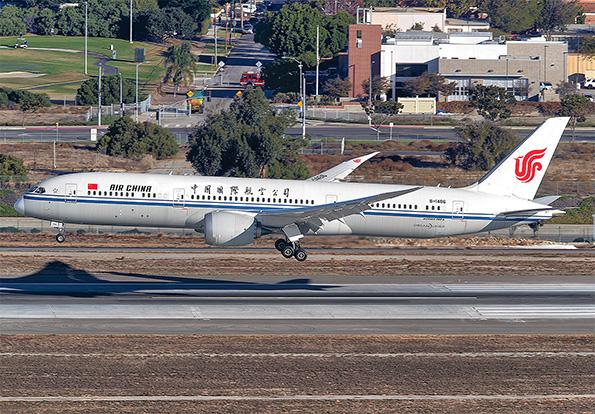
IATA predicts that Asia-Pacific airlines will collectively post $29 billion in losses in 2020 because of the COVID-19 crisis, the largest loss of any global region. Asia-Pacific passenger demand is expected to be down 53.8% year-on-year, with capacity reduced by 39.2%.
The expected year-on-year percentage decline in passenger demand is in the 49%-53% range for almost all of the 17 listed countries. The drop is 1-3 points higher for each country compared with the previous IATA estimates in late April. Sri Lanka tops the list with a 60% demand decline, followed by South Korea with 54%, and Australia, Japan, the Maldives, Pakistan and Thailand with 53%.
Japan has the highest passenger volume decline with a 99.8 million year-on-year drop. India is expected to see a 93.3 million decrease, with South Korea down by 61.4 million and Indonesia 60.1 million. These figures include domestic and international passengers in each market.
Projected revenue drops are equally dire. Airline revenue is expected to be down by $23.9 billion in the Japan market, including local and overseas-based carriers. The revenue drop is forecast to be $14.8 billion for Australia, $11.6 billion for India, and $11.1 billion for Korea.
Throughout the region, a tipping point appears to be approaching as an increasing number of airlines prepare to boost domestic flights. New Zealand announced in mid-May that lockdown restrictions would be eased, prompting Air New Zealand to restore several domestic services. But the situation remains fluid in many markets. Korean Air has been adding back frequencies on its core domestic routes and intended to open another six of its thinner routes from mid-May. But the carrier later said these six routes would remain suspended.
China, where the virus first emerged, took drastic measures to put the country into lockdown by the end of January, just as the Chinese New Year holidays began. The three state carriers, Air China, China Eastern and China Southern, saw an average 85.3% year-over-year (YOY) decline in passenger numbers in February, while capacity cuts were in the range of 68%-75%.
The Civil Aviation Administration of China (CAAC) estimates the country’s aviation industry lost about CNY39.8 billion ($5.6 billion) through the first quarter. The nation’s largest airline, China Southern, lost CNY5.3 billion, and one of the most profitable carriers, LCC Spring Airlines, ended its double-digit profit streak with a CNY227 million loss.
Turning point
However, the turning point for China’s aviation recovery began in May as airlines in many other regions were essentially grounded. China’s daily passenger movements returned to nearly half of its pre-COVID numbers of around 739,500 and crossed the 1 million mark on June 5. China Eastern and China Southern became the world’s largest operators in May. The “big three” state airlines collectively carried 14.1 million passengers in May an average 53.6% month-on-month growth. Spring Airlines also became the first carrier to see its load factors return to 70%.
China Eastern also offered a CNY3,322 fare that allows travel domestically every weekend for the rest of the year, with a maximum of three sectors on each trip, in an effort to stimulate the local industry and fill seats.
However, a second COVID-19 breakout in Beijing forced authorities to take swift and drastic actions in the city, forcing home carrier Air China to cancel around 40% of flights on June 17.
More broadly, Asia’s two major air hubs, Hong Kong and Singapore, were more severely hit. With no domestic network to fall back on, Hong Kong International Airport and Changi Airport’s monthly passenger volumes fell to as low as 35,000 and 24,500 in May, respectively.
Although Cathay Pacific started the year with $20 billion liquidity, it incurred monthly losses of up to $3 billion following the grounding of its fleet. On June 9, the Hong Kong government injected HK$7.8 billion ($1 billion) in loans and another HK$19.5 billion in shares to ensure the carrier’s future. Cathay will also launch another HK$11.7 billion rights issue of shares.
A barometer of the financial market sentiments of the aviation industry in the long term, the Hong Kong Airport Authority secured HK$35 billion in loans from 21 local and foreign banks, primarily for the development of the Third Runway System project on track for completion in 2024.
In Singapore, Changi temporarily suspended operations of Terminals 2 and 4. Operator Changi Airport Group used this opportunity to bring forward and speed up expansion works of T2. The mega T5 project is also delayed for two years to alter designs so they are better suited for post COVID-19 operations.
Flag carrier Singapore Airlines (SIA) announced its first-ever fiscal loss of S$212 million ($148 million) for FY2019-2020, dragged down by the COVID-impacted last quarter and a S$710 million fuel hedging loss. SIA gradually increased capacity through July, albeit from a 94% cut, as Singapore reallowed the transit of passengers through Changi.
The Singapore government, meanwhile, has subsidized 75% of aviation employee salaries, with a cap of S$4,600. On June 8, SIA announced it had secured S$10 billion in liquidity through a rights issue as well as new nonsecured and secured loans from various sources. With the largest sum in the region, SIA is likely to emerge from the pandemic as one of the strongest airlines in the region, if not the world.
Matters are far more challenging for airlines and airports in Singapore’s neighboring countries. Malaysia and Indonesia lifted load factor restrictions on airlines in June and Malaysia’s prime minister appointed petroleum company chief Wan Zulkiflee Wan Ariffin as the new chairman of Malaysia Airlines Berhad (MAB). MAB is also going ahead with its long-planned partnership with fellow oneworld alliance carrier Japan Airlines (JAL).
AirAsia, the region’s largest LCC, has indicated it raised RM1 billion ($235 million) debt funding from various institutions, some of which would be eligible for loan guarantees under a Malaysian government program.
The AirAsia Group’s Philippine and Indonesian entities are also in the process of applying for bank loans. The Philippine unit has requested a government guaranteed loan under that country’s economic stimulus package.
Auditors Ernst & Young raised a red flag regarding the airline’s financial situation as part of its assessment of AirAsia’s financial report for the year ended Dec. 31, 2019. The auditor said elements of the financial report highlighted AirAsia’s significant 2019 net loss, the fall in air traffic demand, and the fact that liabilities exceed assets by RM1.8 billion. However, the auditor also noted that booking trends are improving, and said the airline’s ability to stay afloat will depend to a large extent on the favorable outcome of its negotiations to raise funds.
AirAsia is also seeking to sell 10% of its shares to South Korea conglomerate SK Corp. to raise around $78 million.
COVID-19 was the final straw that broke tourism-dependent Thai Airways. The Thai government brought the flag carrier into bankruptcy court and has approved a rehabilitation plan that includes a reformed board with four new members. The move supersedes a THB58 billion ($1.8 billion) government loan and saw the airline lose its status as a solely state-owned enterprise after Vayupak 1 Fund bought a 3.17% stake.
Eight Thai LCCs have also banded together, seeking THB24.15 billion in government financial, but not in time to save NokScoot, which folded after the board passed a resolution to liquidate the long-haul LCC and return seven Boeing 777-200s to SIA.
Thai AirAsia also hopes to merge with another local LCC, but with no clarity on the reopening of borders, it is not expected that international flights on which Thai airlines heavily depend will resume before late August.
EARLY ACTION
Fortunes have been relatively brighter in Vietnam, which took control of the pandemic spread early and resumed domestic travel in mid-April. Vietnam Airlines and Vietjet Air have restored their entire domestic networks to 2019 levels or higher. Bamboo Airways has also remained resilient and committed to expanding its fleet to 40 aircraft by the end of the year.
Nonetheless, Vietnam Airlines was forced to divest its 46% share in Cambodia Angkor Air, although it might eventually gain full ownership of Jetstar Pacific should it acquire Qantas Group’s 30% stake.
Vietjet posted a VND989 billion ($42.2 million) loss for the first quarter but was the first carrier in Vietnam to resume all 45 domestic flights on May 10.
For Japanese carriers, COVID delivered a major blow when the 2020 Olympics were postponed to next year. The government has not injected any financial stimulus into the country’s airlines but is deferring some tax obligations and subsidizing leave allowances for furloughed staff.
JAL has borrowed JPY200 billion ($1.8 billion) and is looking to raise another JPY300 billion. While most international flights remain suspended, domestic flights are reviving after the government lifted an internal travel ban and JAL was looking to restore 7% of international flights around mid-July.
All Nippon Airways (ANA) saw its profit for the fiscal year ending March 31 nosedive 75% YOY to JPY27.6 billion. ANA has secured at least JPY250 billion in loans and was working on another JPY330 billion from financial institutions.
In South Korea, Korean Air posted a first-quarter loss of KRW692 billion ($561 million) and sought to raise KRW1 trillion from rights issues plus KRW1.2 trillion in government-backed loans and bonds.
Asiana and Hyundai Development Co. got into a dispute about information provided for Hyundai’s proposed acquisition of a 31% stake from majority holder Kumho Industrial, potentially jeopardizing that deal.
In Australia and New Zealand, governments locked down their countries early and essentially turned their airlines, including Qantas and Air New Zealand, into domestic carriers.
Virgin Australia entered voluntary administration in April but, in a sign that there are still buyers for airlines, received several bids. Bain Capital was announced as the preferred bidder in June, although creditors will need to confirm the deal in August.
Qantas has created a new three-year strategy that includes cutting almost 20% of its workforce, storing or retiring larger widebodies, including the last of its Boeing 747-400s, and raising A$1.9 billion ($1.3 billion) in new equity. When international services do resume, the airline will use Airbus A330s and Boeing 787s, but CEO Alan Joyce said most scheduled international flights will not resume before July 2021.
But Joyce said he still intends to order A350-1000s at some point for the carrier’s proposed ultra-long-haul flights, known as Project Sunrise, even though that program has been delayed.
New Air New Zealand CEO Greg Foran has laid out an 800-day action plan that will involve flying fewer routes and further cost-cutting to return to “healthy profits” by 2022. The airline will shrink to 70% of its pre-COVID size and is not anticipating restoring most long-haul routes until 2021.
– David Casey and Adrian Schofield contributed to this report.

